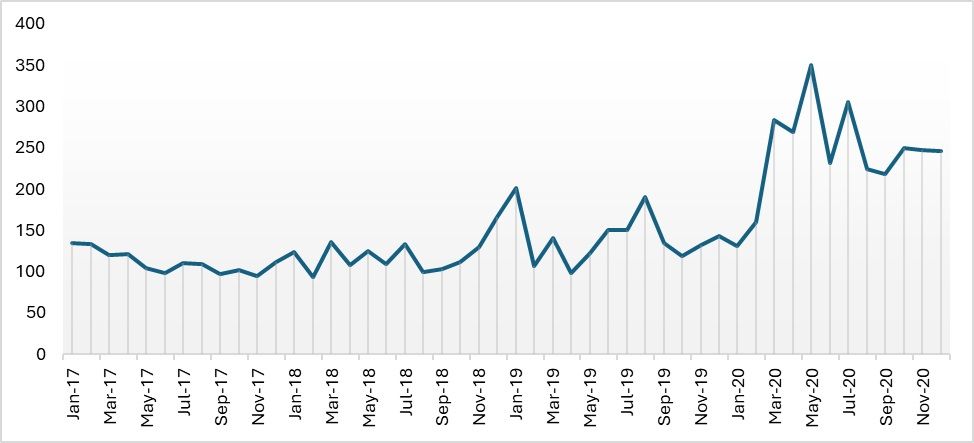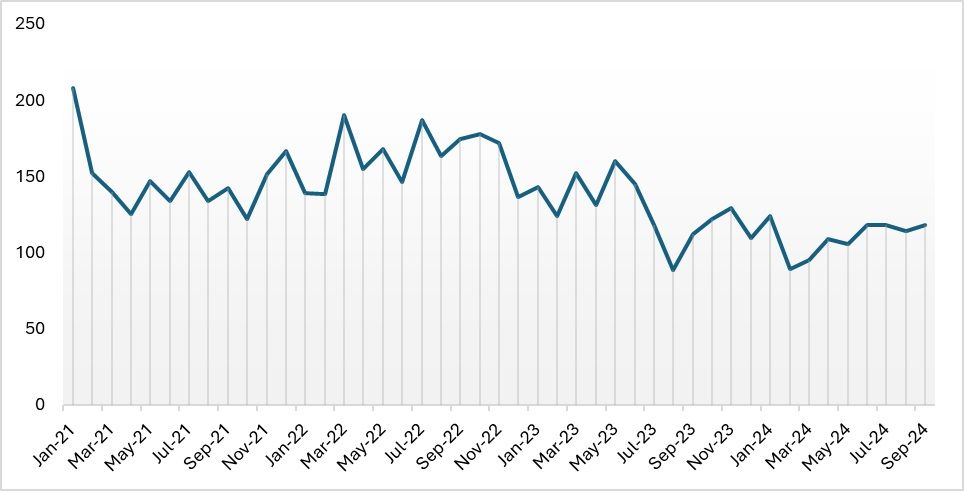
With the upcoming US elections in November, there is growing concern over how future trade policies might impact Asian nations, particularly in terms of their exports and manufacturing costs. If a ban or severe restrictions are placed on trade links with China, industries such as textiles could face indirect but notable effects. While the textile trade might be only marginally impacted, Donald Trump's proposed 20 per cent blanket tariff could have significant repercussions for a wide range of exports, affecting all trading partners. Additionally, Kamala Harris’ climate policies, with a focus on sustainability, could indirectly raise production costs in exporting countries, thereby reducing their competitiveness in the US market.
Asian countries’ competitiveness in the US
China dominates nearly all sectors in the US market, including textiles, where it remains the leading exporter. However, several emerging nations are gaining ground and demonstrating increasing competitiveness, both with China and among themselves. Countries like Vietnam, Indonesia, Cambodia, and India are rapidly expanding their presence in the global textile and apparel trade. Due to their growing supply chain capabilities, these nations have the potential to become top exporters in the world. The following provides insight into how these countries are competing in textile exports to the US, a key consumer market.
Table 1: Asian countries’ textile exports to the US as a percentage of total textile exports

Source: ITC Trade Map, F2F Analysis
In 2023, the US was the top importer of apparel in the world, accounting for 18 per cent of total apparel imports, followed by Germany, France, and Japan. The US is the largest consumer market for apparel and textile products, including home textiles, followed by the EU and Australia.
Vietnam is the largest exporter of apparel to the US, accounting for 41 per cent of textile exports to the US, followed by Indonesia, Cambodia, and India. Donald Trump's import policies could disrupt the US economy.
The Export Similarity Index (ESI) is used to calculate the degree of competitiveness between the exports of two countries in a third country, which is the consumer market—in this case, the US. The ESI revealed some interesting trends for the top emerging exporting countries.
Table 2: ESI of India with other textile-exporting countries

Source: ITC Trade Map, F2F Analysis
India stands as a textile powerhouse in Asia, with its exports to the US accounting for 27 per cent of its total textile exports. When comparing India's textile export competitiveness with other countries like China, Vietnam, and Cambodia, the landscape has shifted notably. The competitive gap between China and India has significantly diminished, largely due to US sanctions on Chinese textile exports, which have heavily impacted China’s trade in this sector. Meanwhile, India’s competitiveness with Vietnam, Cambodia, and Indonesia remains on similar terms. A recent change of just 3 per cent in the Export Share Index (ESI) indicates a gradual increase in the competitiveness between the two nations with the US as a common market.
Table 3: ESI of Vietnam with different textile-exporting countries

Source: ITC Trade Map, F2F analysis
If we look at the ESI of Vietnam's textile exports to the US in comparison with different countries, Vietnam's competitiveness with Cambodia and Indonesia is higher than with China and India. The reason is that all three countries have textiles accounting for a significant portion of their exports, and they compete within the continent based on raw material sourcing, while also competing in nearly all segments, including fabrics, apparel, and home textiles. With Cambodia, the competition is particularly strong in apparel exports. In addition to conventional apparel, Cambodia also exports denim apparel and workwear made from various fabrics. However, out of the three countries, Vietnam benefits the most in terms of apparel exports due to its Bilateral Trade Agreement (BTA) with the US.
Table 4: ESI of Cambodia with other textile exporting countries

Source: ITC Trade Map, F2F analysis
Cambodia’s textile exports face stiff competition from other major textile-exporting nations, particularly Indonesia and Vietnam. While its competitiveness with China is increasing marginally, Cambodia is also contending with significant competition from India, Bangladesh, Indonesia, and Vietnam. Politically and economically, Cambodia's relations with the US have become strained recently, yet its garment exports remain unaffected as garments and footwear were excluded from the GSP exemption list. Competition with Bangladesh has eased somewhat over time, though both nations still compete on similar factors such as labour, raw material sourcing, and the variety of textiles produced. However, Cambodia retains an advantage with its lower labour costs, a factor where Bangladesh is comparatively less competitive.
Table 5: ESI of Bangladesh with other textile-exporting countries

Source: ITC Trade Map, F2F Analysis
US’ trade relations with other nations and their potential impact
Vietnam, on the other hand, is an export-reliant economy that could be affected if Donald Trump were to return to the presidency. Trump has previously pushed Vietnam to import more from the US in an effort to reduce the wide trade deficits between the two countries. Vietnam largely benefits from the bilateral trade agreement (BTA), which has resulted in higher exports to the US. However, with Donald Trump back in the picture, there is a higher possibility that the US will demand increased imports from Vietnam to reduce the widening deficit. The recent trade deficit of the US with Vietnam was $109.29 billion, a reduction of 12 per cent, though the gap remains significant. Despite this, the country’s garment exports were not majorly impacted, though there was a slight reduction in the growth of exports, which still managed to increase overall.
The impact of Trump’s approach and policy decisions can be seen as a fluctuating spike in the policy uncertainty index. Trump’s unpredictable stance and the uncertainty surrounding his policies for the US and its foreign relations led many export-driven economies to develop long-term strategies for de-risking.
Exhibit 1: Economic Policy Uncertainty Index for the US under Donald Trump

Source: Economic Policy Uncertainty Index
For Bangladesh, the US is a key market for apparel and textile exports, second only to the EU. The US is also one of the largest sources of FDI in Bangladesh, with investments totalling around $3 billion, followed by the UK. While Donald Trump did not take a strong stance against Bangladesh, the current political and economic situation, coupled with the US' evolving approach under different leadership, will shape the future of FDI and financial assistance in the country. If Trump returns to power, Bangladesh may see a reduction in funds and investments aimed at climate change initiatives and sustainable technology collaborations, which could undermine its textile industry's technological progress.
Trump's dual approach to India, particularly regarding trade policy, tariffs, and subsidies, could further reduce its competitiveness if his policies turn more protectionist against India. However, in terms of textile exports, Trump’s rhetoric against China could indirectly benefit India, which remains relatively disconnected from Chinese supply chains and has a large domestic market to support its production. While tariffs on Indian textiles might not be lifted, it is likely that India's textile exports would not face significant harm under a Trump administration.
Kamala Harris, on the other hand, offers a broader perspective that intertwines trade, geopolitics, and de-risking strategies. While her stance on China remains firm, subtle shifts in relations with other nations are possible. Unlike Trump’s individualised focus on trade, Harris emphasises investments, smoother cross-border trade, and sustainability in production—factors that could influence the textile industries of Asian countries.
The sustainability angle
Kamala Harris is likely to prioritise sustainability, advocating for policies that improve fashion and apparel production chains both domestically and among US trading partners. Bangladesh, for instance, received approximately $12.5 million from the International Finance Corporation to promote sustainable production. Under a Harris administration, there could be an increased emphasis on sustainability in textile value chains, potentially affecting countries like India and Vietnam, which currently lack comprehensive sustainable textile policies.
However, overall trade relations between the US and these countries would likely remain stable under Harris, as her policies do not suggest drastic changes in trade dynamics. A key differentiator, though, is Harris’s more Asia-friendly approach, which could lead to stronger collaboration on sustainability and climate change initiatives. This focus could encourage textile-producing nations to implement policies that enhance the sustainability of their value chains, potentially driving modernisation and competitiveness in the global textile market.
Exhibit 2: Economic policy uncertainty under Joe Biden

Source: Economic Policy Uncertainty Index
In terms of signing trade agreements, Kamala Harris may follow the same steps as her predecessor, Joe Biden. Although Biden did not specifically intervene in any trade policies except for those involving China, he also did not restart negotiations for the Trans-Pacific Partnership agreement, which might have boosted Vietnam's access to the US. Harris may similarly be hesitant to expand on this.
Harris has emphasised that sustainability and climate change will be central to the policies implemented by her administration. While US apparel companies are cautious about such regulations, exporting countries will also need to adapt. Sustainability policies introduced in the US are likely to have a ripple effect, eventually influencing manufacturing practices in Asia. Unlike the EU’s direct imposition of taxes under the CBAM policy, Harris’s approach suggests a more gradual, domino effect in which policies are implemented progressively.
Although trade is unlikely to face major disruptions under a Harris administration, relations will largely maintain the status quo. However, there could be an increase in collaboration on climate change, sustainability, labour laws, and humanitarian causes. These shifts could indirectly affect the textile trade between Asian nations and the US, as exporting countries will need to align with these evolving standards to remain competitive in the global market.
Road ahead
In terms of market access to the US, countries like Cambodia, Bangladesh, and Vietnam are engaged in intense competition. However, the outcome of the US elections will significantly impact their trade prospects.
Trump’s tenure was marked by disruptive and unpredictable policy changes, with little concern for climate policies or sustainability. Under his leadership, countries like Bangladesh and Vietnam, which have fostered partnerships with the US around technology exchange, labour laws, humanitarian support, and women's empowerment, may see a reduction or withdrawal of US assistance in these areas. This could hurt their competitiveness and economic ties with the US.
Regardless of who wins the White House, garment and textile exports from these countries are likely to either remain stable or, in a worst-case scenario, decline if Trump follows through with his proposed 20 per cent blanket tariff. Beyond the leaders' individual approaches to Asia, their stance on key geopolitical issues will also influence manufacturing costs and supply chains, which could, in turn, impact the apparel and textile trade.
Both Trump and Harris share a strong opposition to Chinese trade practices, particularly China’s dumping methods. Trump’s strategy of imposing a 60 per cent tariff on Chinese imports is still uncertain in its full scope. While he hasn’t specifically targeted countries like Vietnam, Bangladesh, or Cambodia, which rely heavily on imported textile raw materials from China, there’s a possibility that de minimis thresholds could be tightened, potentially affecting these countries' export competitiveness.
The key difference between the two candidates lies in their approaches. If both seriously pursue their trade policies, the repercussions could be felt not only in the US economy but also across the global supply chains linked to it. Kamala Harris may indirectly increase costs through sustainability initiatives, whereas Donald Trump’s policies would more directly curtail exports and raise the cost of imported goods. Each leader’s stance on trade, tariffs, and climate policy will shape the future of textile exports to the US and the broader economic landscape for Asian countries.
ALCHEMPro News Desk (KL)
Receive daily prices and market insights straight to your inbox. Subscribe to AlchemPro Weekly!